Annecy
Top-Rated Things to Do in Annecy
Annecy has all the trappings of a fairy-tale scene, with white swans gliding through peaceful waterways and a backdrop of snowcapped mountains. Adding to the enchantment, the Old Town (Vieille Ville) is a winding maze of mostly pedestrian, cobblestone streets lined with graceful buildings. Pastel-painted houses feature ornamental wrought-iron balconies and colorful geranium-bedecked windowsills. Potted flowers also adorn the town's canal footbridges and the elegant lakeside promenade.
Visitors will enjoy strolling through the town to discover its storybook charm. Often called the "Venice of the Alps" because of its picturesque waterways, Annecy is a gem of the historic Savoy region at the heart of the northern French Alps.
Nearby are breathtaking nature sites and world-class ski resorts. The magnificent scenery inspires outdoor activities, while cozy chalets and old-fashioned restaurants welcome tourists in traditional alpine style.
Plan your sightseeing with our list of the top things to do in Annecy.
1. Palais de l'Île
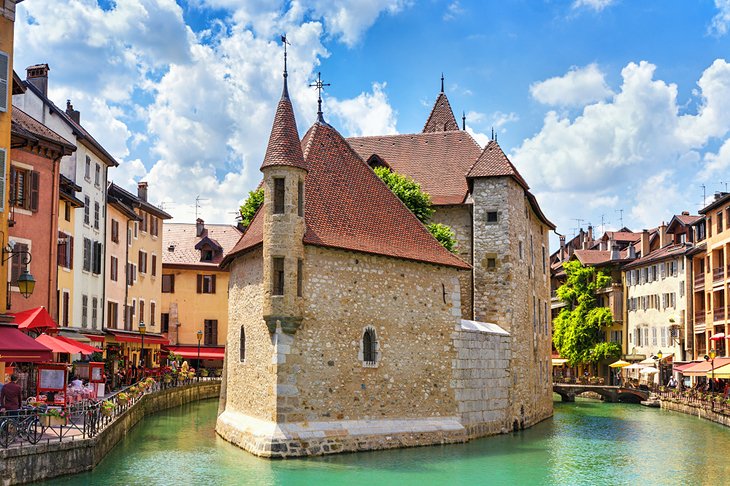
Annecy's most photographed monument, the 12th-century Palais de l'Île stands on an island in the Canal du Thiou. Tourists will find the best views and photo-ops of the Palais de l'Île on the Pont sur le Thiou (bridge). From this vantage point, the palace appears fortress-like with its sturdy quadrangular construction resembling the bow of a ship.
The Palais de l'Ile first served as a prison, but by the mid-14th century, the palace was instead used as a coin-minting workshop. In the 15th century, the palace became the residence of the Dukes of Savoy and in the 16th century was converted to the Palace of Justice (Law Courts).
Open to the public year-round, the Palais de l'Ile now houses a small museum that displays exhibits about the regional architecture. Visitors can also see some of the old prison cells.
2. Château d'Annecy
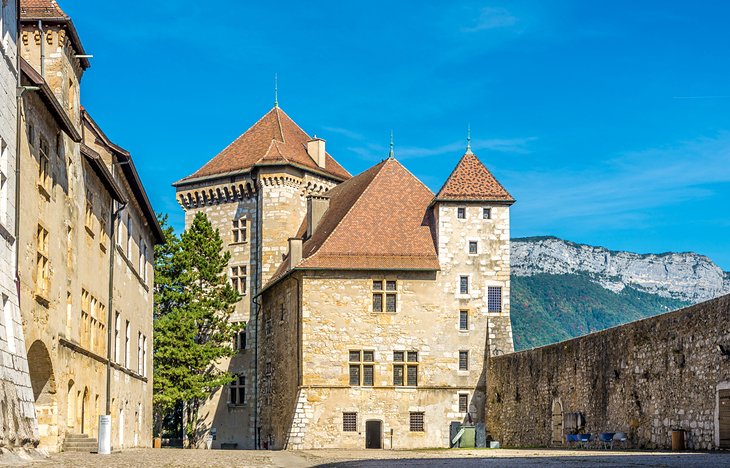
Perched on a hill above the town, the Château d'Annecy affords stunning views of the lake and the surrounding mountains. The castle was built in phases from the medieval to the Renaissance period. During the 13th and 14th century, the Counts of Geneva resided here.
Today, the château is a museum and popular tourist attraction that covers a wide range of disciplines, including regional history, medieval sculpture, landscape painting, and contemporary art. There are also temporary exhibits throughout the year. Tourists can visit the Château d'Annecy year-round, except for holidays and except on Tuesdays during the low season.
3. Recreational Activities at Lac d'Annecy
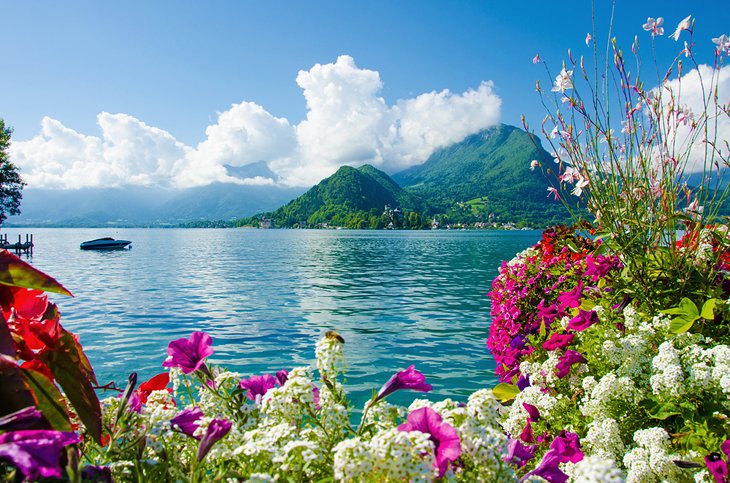
The Lac d'Annecy beckons visitors with its unspoiled alpine beauty and myriad of recreational opportunities. This shimmering expanse of crystal-clear waters is considered the cleanest lake in Europe, plus the scenery is sublime. Snow-dusted mountain peaks provide an inspiring backdrop for walking, cycling, sunbathing, swimming, and boating.
The main beach of Annecy Lake is the Plage d'Albigny (Avenue du Petit Port), which has a spacious grassy area for sunbathing and a path for walking or cycling. Pristine as well as elegant, Albigny Beach is immaculately manicured, with flowers and plants bordering the lawn. This beach has public restrooms and showers. Lakeside staircases allow easy access for swimming. In July and August, lifeguards are on duty from 11am until 7pm.
Next to the Plage d'Albigny within the Parc Charles-Bosson, the Plage de l'Impérial (Avenue d'Albigny) attracts many visitors for relaxation and outdoor activities. The shoreline is a mixture of grass and fine sand. Well equipped with facilities, the Plage de l'Impérial includes a restaurant, picnic area, badminton courts, ping-pong tables, and beach volleyball courts.
Families with kids appreciate the wading pool, playground, mini-golf course, and children's games. During the high season, lifeguards are on duty.
4. Shopping and Dining on Rue Sainte-Claire
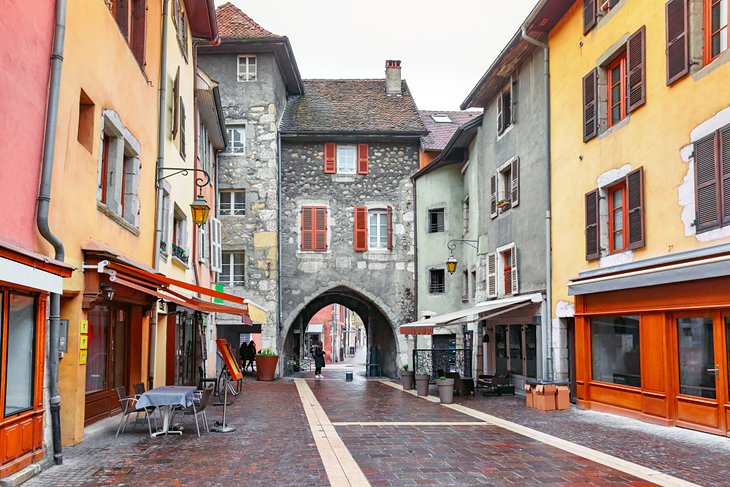
Near the Palais de l'Île, the Rue Sainte-Claire is the place to go in Annecy for shopping and dining. One of the town's main streets, the lively Rue Sainte-Claire is brimming with old-world charm. Arcaded townhouses dating from the 16th to 18th century have retained their historic character. Some of the houses feature lovingly tended flower-bedecked windowsills.
The arcaded area of the street's townhouses is filled with upscale retail stores, trendy cafés, fancy ice-cream shops, and gourmet dining establishments. Tourists will enjoy browsing the boutiques, grabbing a gelato, taking a coffee break, or stopping for a meal at one of the quaint restaurants.
5. Eglise Saint-Maurice
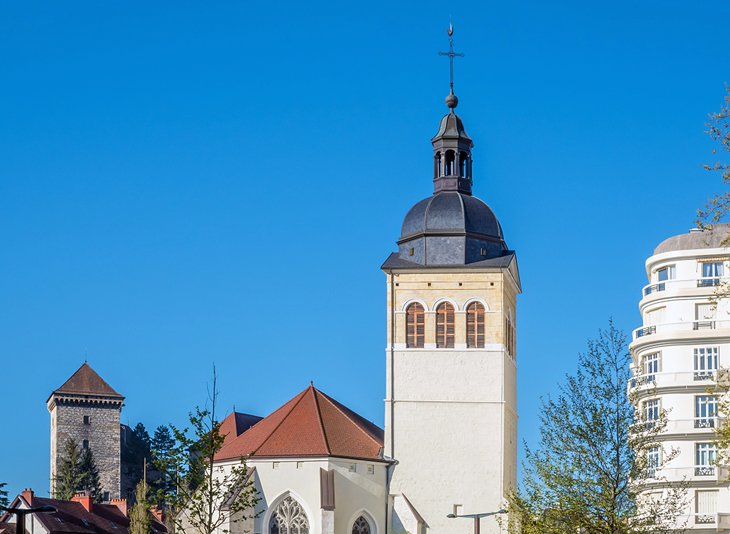
Designated as a historical monument, the Eglise Saint-Maurice is the oldest church in Annecy. This 15th-century church was formerly a chapel for the Dominican convent. By the 19th century, the building became the town's parish church. Today, the church continues to host religious services and is open to the public for visits year-round.
The church exterior reveals distinctive Flamboyant Savoyard architectural elements, while the interior expresses a more somber ambience. The impressively vast nave was designed in the typical style of Dominican churches to accommodate a large congregation. Noteworthy works of art include the elaborately carved pulpit from the 18th century and a painting of the Virgin in Glory.
6. Cathédrale Saint-Pierre
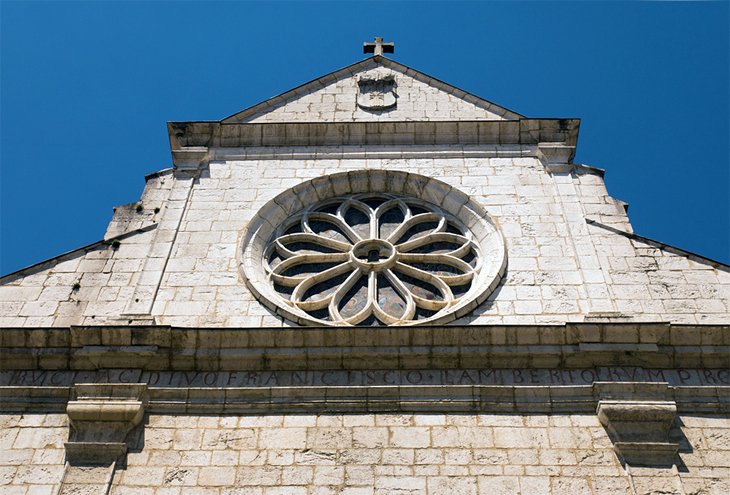
The Cathédrale Saint-Pierre is reached from a narrow side street and is somewhat hidden from view, but it merits taking the time to discover. Built between 1535 and 1538, this church became the cathedral of the Bishops of Geneva, who sought refuge in Annecy during the Protestant Reformation.
The harmonious proportions of Italian Renaissance architecture distinguish the building's exterior, in particular the Tuscan pilasters. Gothic style predominates in the cathedral's interior, with the exception of the Neoclassical choir, which dates to the 18th century. An exquisite rose window and three other stained-glass windows illuminate the sanctuary.
Since 1822, the church has served as the cathedral of the Diocese of Annecy. The Cathédrale Saint-Pierre is listed as a historical monument and is open to the public for visits year-round.
7. Pont des Amours
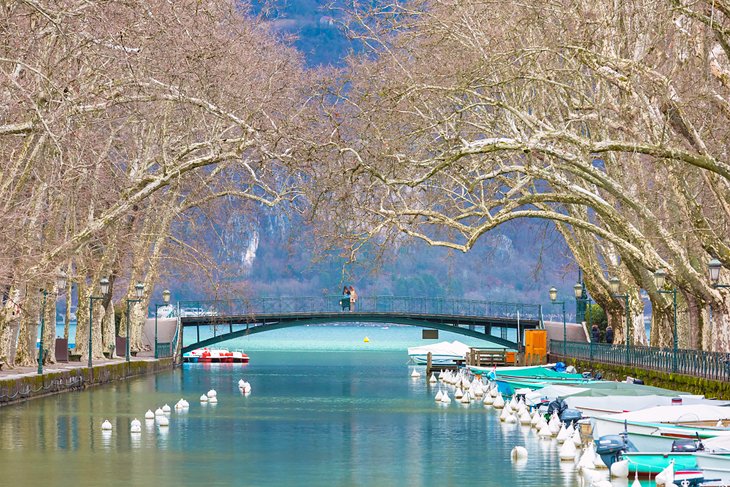
In an idyllic setting beneath a canopy of leafy trees, the fittingly named "Lovers' Bridge" spans the Canal du Vassé that flows from the Lac d'Annecy. This arched ironwork bridge seems to inspire romance with its majestic lakeside scenery.
The Pont des Amours is a popular spot for photo-ops, especially for engagement and wedding portraits. A short walk away from the bridge is the Jardins de l'Europe park.
8. Picnic on the Champs de Mars
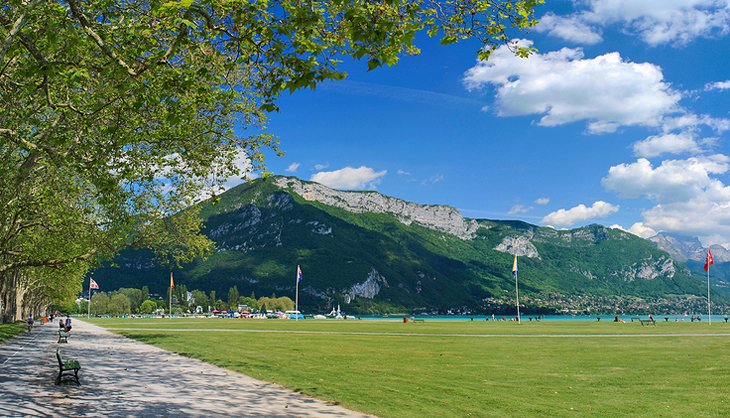
This seven-hectare Champs de Mars borders the Lac d'Annecy and the Jardins de l'Europe, so the views are superb. The Champs de Mars is also known as "le Pâquier" ("pasturage" in the local dialect) because domestic animals once came to graze here.
Nowadays, this expansive green space is a favorite spot for locals to enjoy picnics and recreational activities on sunny days. Several paved cycling paths traverse the Champs de Mars.
Families with young kids will have fun at the Champs de Mars. Children love the park's mini horses and small train. Youngsters (and anyone young at heart) will relish the chance to glide around the turquoise waters of Lake Annecy. On the lake side of the park, visitors can find pedal boats and row boats available for rent by the hour.
During summertime, the Champs de Mars hosts cultural events such as the Fête de la Musique (Festival of Music) on June 21st and the Fête du Lac (Festival of the Lake) held every year on the first Saturday of August. The Fête du Lac is Europe's largest fireworks show. There are also fireworks shows presented for the Fête Nationale du 14 Juillet (Bastille Day), along with an orchestra performance.
9. Jardins de l'Europe
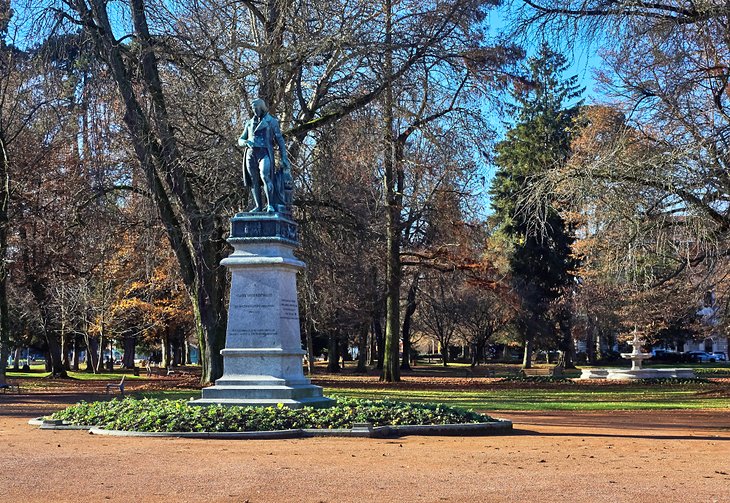
The Jardins de l'Europe is another beautiful leafy park beside the lake. This luxuriant flower-filled green space is found next to the Pont des Amours and offers views of the Chateau d'Annecy. The Eglise Saint-Maurice is a short walk away from the gardens.
If visiting Annecy during the Fête Nationale du 14 Juillet (Bastille Day), one of the most exciting things to do is watch the fireworks show from the Jardins de l'Europe. This fireworks show rivals the one held on July 14th at the Champs du Mars.
10. Basilique de la Visitation
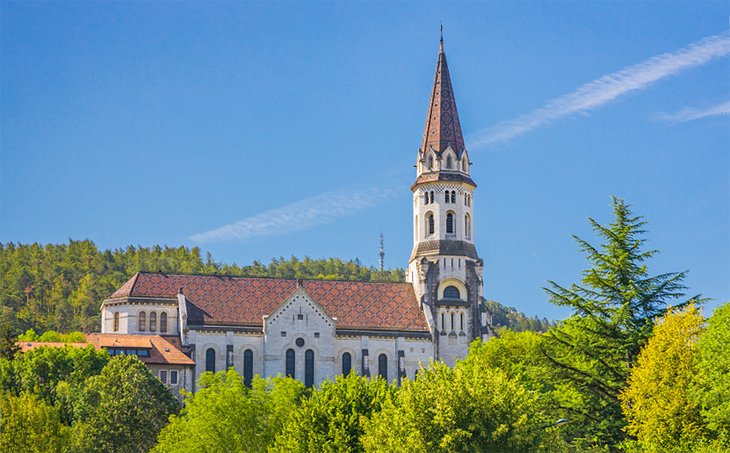
Crowning a hilltop above the Old Town, this neo-Romanesque church holds Mass and Vespers daily. The church is also open to the public for visits outside of religious services. To arrive here requires a steep and somewhat strenuous hike from the Old Town, but glorious views of the Annecy landscape reward the effort.
The basilica's unembellished exterior contrasts with the ornate interior featuring blue Savoy marble columns in the nave, Venetian-enameled mosaics in the apse, and vibrant stained-glass windows that depict the story of Saint François de Sales.
11. Eglise Notre-Dame de Liesse
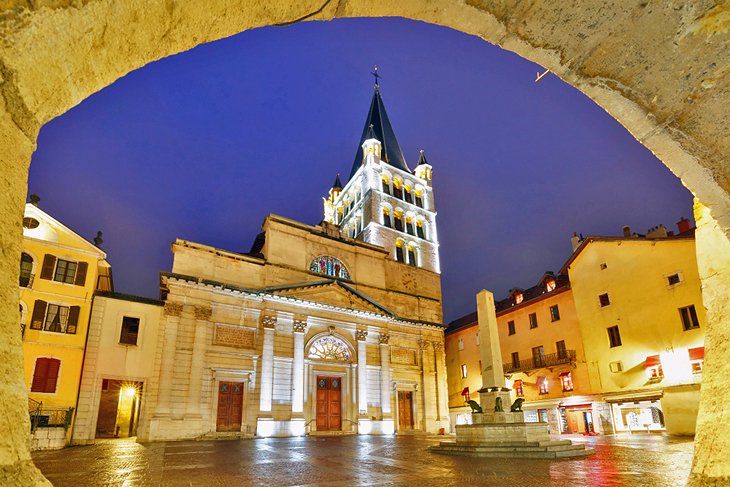
Except for the 14th- to 15th-century bell tower, the Eglise Notre-Dame de Liesse was built in the 19th century after the original monument at this site was destroyed during the French Revolution. The simple facade and domed interior with Corinthian columns are typical of Sardinian Neoclassical architecture. This style of building design developed between 1830 and 1850 when the Savoy state was under the rule of the Kingdom of Sardinia.
The church is open to the public for visits every day year-round. Mass is celebrated here on Sundays.
12. Eglise Saint-François de Sales
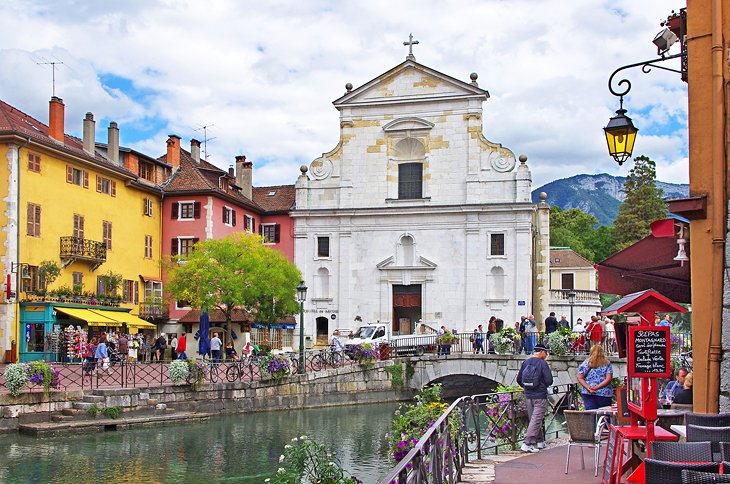
This 17th-century church contains the tombs of two important religious figures of the region: Saint Joan of Chantal and Saint Francis de Sales. With its Italianate facade and richly adorned Baroque interior, the church is a wonderful example of Counter-Reformation-era architecture. The church is open to the public for visits year-round.
13. Avenue d'Albigny
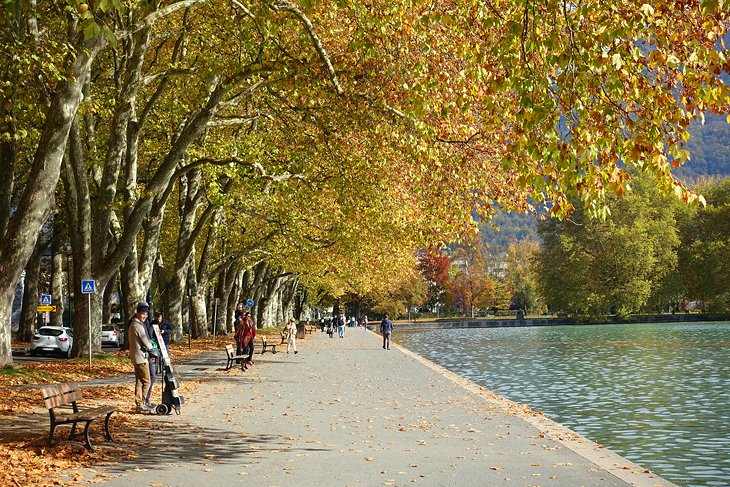
Beginning near the Jardins de l'Europe and extending to the Parc Charles-Bosson, the Avenue d'Albigny is a scenic stretch of shoreline alongside the Lac d'Annecy. Tall, leafy plane trees shade the lakeside pedestrian path, which is a pleasant place for a leisurely ramble while admiring the picture-perfect lakeside scenery.
14. Retour des Alpages
Every year on the second Saturday of October, the streets of Annecy become the scene of a folkloric festival. Celebrated since the Middle Ages, the Retour des Alpages (Return from the Pastures) marks the moment when the herds of alpine cows return from their summer pastures in the mountains to spend the autumn and winter season in the valley.
A parade of cows begins the convivial event, which continues with folk music performances, artisan craft demonstrations, and samplings of regional food products. The parade begins at the Rue Sainte-Claire at 2:30pm and winds through the Vieille Ville. Musical entertainment takes place at squares throughout the town.
15. Musée du Film d'Animation
Just steps away from the Château d'Annecy, the Musée du Film d'Animation (18 Avenue de Tresum) presents interesting exhibits about animation cinema. The collection helps visitors understand the animation creation process through thematic topics such as lighting and the illusion of movement. Exhibits also show images of animated cinema spanning the past century, providing perspective on the evolution of the art form.
Beautiful Castles near Annecy
Chateau de Menthon Saint-Bernard
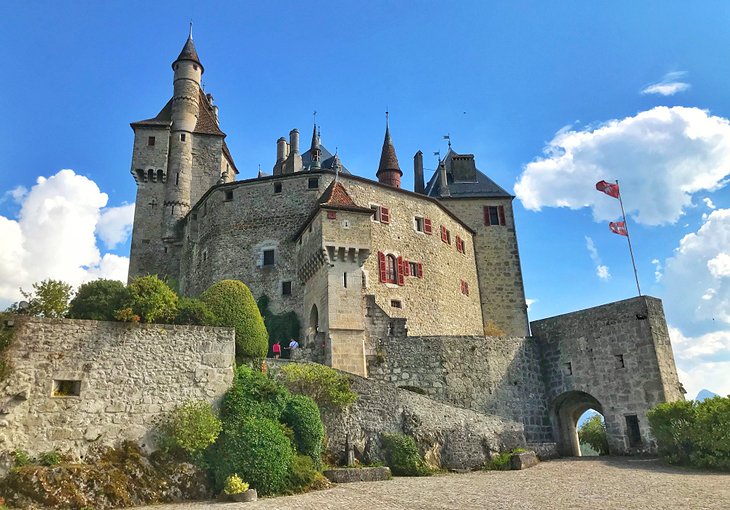
About a 20-minute drive from Annecy, this dreamy castle stands on a hilltop overlooking Lac d'Annecy. The Chateau de Menthon Saint-Bernard dates to the 12th century and has been home to the esteemed Menthon family for 23 generations (almost 1,000 years).
Because of its idyllic setting, the castle is often used as a venue for weddings and receptions. From April through October, the Chateau de Menthon Saint-Bernard is open to the public for guided tours in French (with information printed in English).
Château de Montrottier
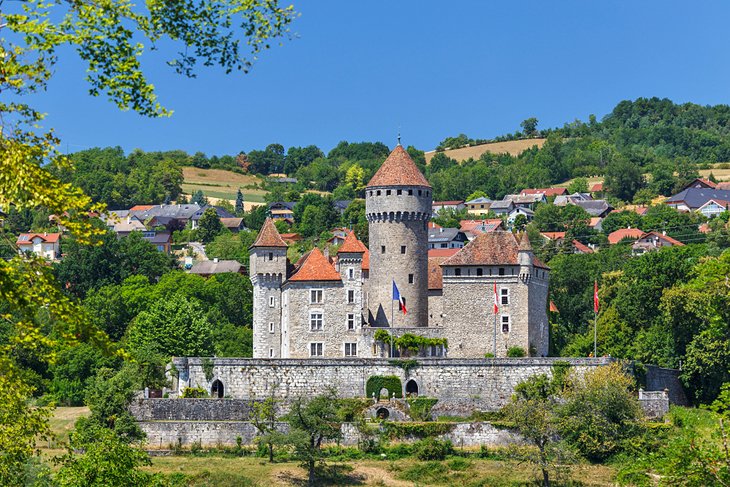
The Château de Montrottier is nestled in the village of Lovagny just 12 kilometers from Annecy, about a 20-minute drive. In its magical setting of wooded hillsides, this turreted medieval fortress resembles the images of storybook castles. Walking through the castle's grand halls and ancient dungeon feels like stepping back in time.
Weddings ceremonies are often held on the castle grounds, and receptions are hosted in the Guards' Room. The Château de Montrottier is open to the public for self-guided visits from March through September.
Château de Clermont
Built in the 16th century, this Renaissance castle is a rare example of Italian architecture in the Savoy region. The Château de Clermont was the summer residence of Monseigneur Gallois Regard who had familial connections with the Popes in Rome.
Listed as a historical monument, the building impresses visitors with its monumentally proportioned facade and graceful arcaded galleries that frame a quiet interior courtyard. The castle is open to the public for guided visits from May through October.
(thanks to: www.planetware.com)
Comments
Post a Comment